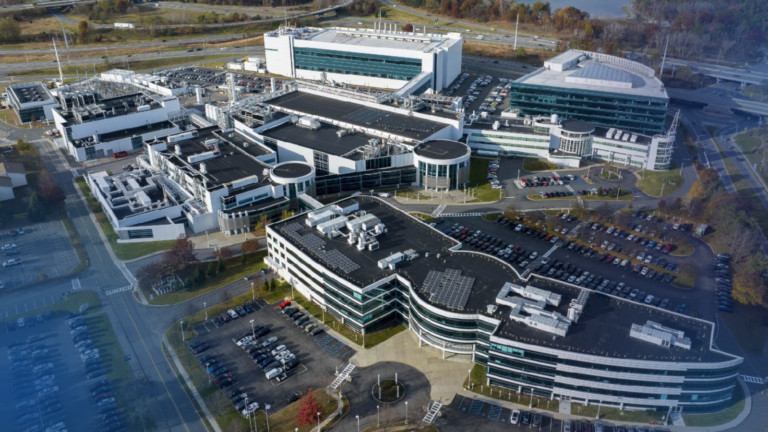
Report by Charles Wessner & Thomas Howell
Published, Feb. 14, 2025
The CHIPS and Science Act of 2022 (CHIPS Act) was critically important for halting and reversing the erosion of U.S. semiconductor manufacturing capability and ensuring the security of the domestic chip supply chain. Through a combination of federal grants (up to $39 billion) and tax incentives (in excess of $46 billion), the CHIPS Act has stimulated billions of dollars in private sector investments into U.S.-based semiconductor manufacturing.
The CHIPS Act established the National Semiconductor Technology Center (NSTC), an industry-government-academic collaboration meant to drive advanced semiconductor research, development, and workforce training.
In July 2024, the Department of Commerce and the recently created National Center for the Advancement of Semiconductor Technology (Natcast), the nonprofit operator of the NSTC, began the site-selection processes to identify the first three NSTC flagship facilities:
-
- An administrative and chip design center.
-
- An extreme ultraviolet light (EUV) lithography center will provide participants with the ability to utilize the most advanced lithography tools to facilitate the development of chips at the leading-edge of semiconductor technology, specifically those needed to support artificial intelligence applications.
-
- A prototyping and advanced packaging piloting facility will combine state-of-the-art 300-millimeter (mm) manufacturing with chip prototyping and packaging, set to be operational in 2028.
The Commerce Department and Natcast conducted separate site selection processes for each facility. Selection criteria included the presence of a thriving semiconductor ecosystem at the proposed sites, with secondary considerations including chip industry presence; the availability of skilled workers; the number and quality of relevant worker training programs; the number and quality of nearby university research programs focusing on microelectronics; the amount of public and private chip investments in the preceding decade; and the number and type of benefits, incentives, and initiatives aimed at the semiconductor industry.
In July 2024, in a bid by the state to secure the designation of the facility as one or more of the NSTC’s foundational centers, $1 billion was invested into the semiconductor research facility at the New York Center for Research, Economic Advancement, Technology, Engineering, and Science’s (NY CREATES) Albany NanoTech Complex—hereafter referred to as Albany NanoTech.
Indeed, reflecting its unique advantages, in October 2024, the Department of Commerce and Natcast designated Albany NanoTech as the first NSTC research and development facility. Specifically, it will serve as the NSTC’s EUV lithography center, supported by a proposed federal investment of an estimated $825 million. The center is expected to begin initial operations in 2025.
In the following months, the Department of Commerce and Natcast also announced that the Design and Collaboration Facility would be established in California, while the Prototyping and National Advanced Packaging Manufacturing Program (NAPMP) Advanced Packaging Piloting Facility would be established at Arizona State University.
The selection of Albany NanoTech as the site for the NSTC’s EUV lithography R&D center validates New York’s investments in Albany. It was not lost on observers that Albany NanoTech was the first of the three NSTC flagship facility sites designated by the U.S. government, with Silicon Valley coming in second, signaling “a major shift in the center of power in the U.S. computer chip industry.” David Anderson, the president of NY CREATES, observed that the federal action was “a recognition and solidification of the Albany NanoTech center and NY CREATES as a national resource. We really are a gem for this industry and the capabilities that we have here.”
NY CREATES Albany NanoTech Complex
While the perspectives offered by Anderson might be brushed off as the sort of local boosterism commonly associated with site selections for major federal projects, his case for Albany NanoTech is grounded in a number of fundamental realities. While not fully appreciated, especially in Washington, Albany NanoTech stands at the epicenter of a long-standing, thriving semiconductor research and manufacturing ecosystem with few parallels in the United States, or worldwide. Albany NanoTech brings together cutting-edge facilities, actively engaged partners from leading device manufactures and equipment suppliers, collaborative research relationships with leading universities, and a state government already making the significant capital investments needed for such a facility to remain state-of-the-art. Key features of this remarkable institution include the following:
-
- Exceptional Facilities and Tools: Albany NanoTech offers the best—if not the only—publicly available, neutral site capable of fully supporting the proposed NSTC EUV lithography center. Indeed, besides Belgium’s imec, Albany NanoTech is the only global research center scheduled to receive the newest ASML High-NA EUV machine, set to be installed in a new facility currently under construction. Albany NanoTech is the only such recipient in North America that is not a major private firm.
-
- Bipartisan State Government Support: The New York state government’s support for the promotion of local semiconductor research and manufacturing has been unwavering for decades, involves billions of dollars in public outlays, and remains rock-solid. It is a leading priority of Governor Kathy Hochul.
-
- Large-Scale Private Investments: The public and private sector have undertaken massive investments in chip manufacturing and research in the Albany area for the past decade. Most recently, GlobalFoundries announced an $11.6 billion expansion of its Fab 8 in Malta, New York, beginning in 2025. Additionally, the recently announced investments at Albany NanoTech include another $10 billion in public and private investments.
-
- Existing High-Quality Workforce: Over 10,000 people in the Albany area are already directly employed in semiconductor research, manufacturing, supply chain, and specialty construction companies and institutions.
-
- Exceptional Educational Infrastructure…Read More
